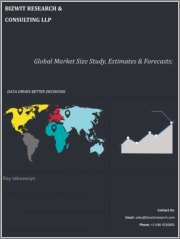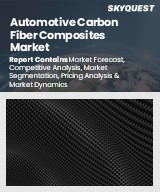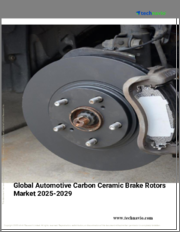
|
시장보고서
상품코드
1407980
세계의 자동차용 탄소 열가소성 수지 시장 규모 조사 및 예측 : 수지 종류별, 용도별, 지역별 분석(2023-2030년)Global Automotive Carbon Thermoplastic Market Size study & Forecast, by Resin Type (PA, PEEK, PPS, PC, PP, Others), by Application (Exterior, Interior, Chassis, Powertrain & UTH) and Regional Analysis, 2023-2030 |
||||||
자동차용 탄소 열가소성 수지 세계 시장은 2022년 약 4억 5,991만 달러로 평가되며, 예측 기간인 2023-2030년에는 13.5% 이상의 건전한 성장률로 성장할 것으로 예상됩니다.
자동차용 탄소 열가소성 수지는 자동차 산업에서 사용되는 재료의 일종으로, 탄소섬유와 열가소성 고분자 매트릭스를 결합한 것을 말합니다. 이 조합은 다양한 자동차 용도에 적합한 특성을 가진 가볍고 고강도의 재료를 얻을 수 있습니다. 탄소 열가소성 수지는 경량화, 연비 향상, 기계적 성능 개선, 비용 절감 가능성 등의 이점을 제공합니다. 자동차용 탄소 열가소성 수지 시장은 무공해 전기차에 대한 수요 증가와 에너지 효율이 높은 자동차에 대한 수요 증가 등의 요인으로 인해 확대되고 있습니다. 그 결과, 2023-2030년 예측 기간 동안 국제 시장에서 자동차용 탄소 열가소성 수지에 대한 수요가 점진적으로 증가하고 있습니다.
탄소 열가소성 수지는 전기자동차 배터리와 관련된 무게 문제를 해결하는 데 중요한 역할을 하고 있습니다. 이러한 재료의 가벼운 무게는 배터리 팩의 무거운 무게를 상쇄하고 전반적인 효율성과 성능에 기여하는 데 도움이되며, Statista에 따르면 2022년 플러그인 전기자동차 판매량은 1,020 만 대에 달할 것으로 예상됩니다. 또한 2022년에는 전 세계적으로 약 290만 대의 플러그인 하이브리드 전기차가 새로 판매될 것으로 예상됩니다. 플러그인 하이브리드 전기차 판매량은 2022년 전기차 판매량의 약 28.4%를 차지합니다. 자동차용 탄소 열가소성 수지 시장을 이끄는 또 다른 중요한 요인은 에너지 효율이 높은 자동차에 대한 수요 증가입니다. 자동차 산업에서 하이브리드 및 플러그인 하이브리드 자동차의 생산이 증가하고 있습니다. 탄소계 열가소성 수지는 이러한 자동차에서 경량화에 기여함으로써 중요한 역할을 하고 있으며, 특히 하이브리드 시스템에서 배터리의 추가 중량을 상쇄하는 것이 중요합니다. 또한, Statista에 따르면 2021년에는 루시드 에어 G 투어링 AWD 모델이 대형 자동차 시장의 에너지 효율 리더로 부상하여 휘발유 환산 시 갤런당 131마일의 주행거리로 모든 소형 승용차를 능가하는 것으로 나타났습니다. 또한, 자동차 산업에서 경량화 및 부품 통합에 대한 관심이 높아지고 자동차용 탄소 열가소성 수지의 기술 발전이 증가함에 따라 예측 기간 동안 시장에 유리한 성장 기회를 창출할 것으로 예상됩니다. 그러나 탄소섬유의 높은 비용과 복합 부품의 재활용 가능성은 2023-2030년 예측 기간 동안 전체 시장 성장을 저해할 것으로 보입니다.
자동차용 탄소 열가소성 수지 세계 시장 조사에서 고려된 주요 지역은 아시아태평양, 북미, 유럽, 라틴아메리카, 중동 및 아프리카지역입니다. 북미는 이 지역 자동차 산업에서 기존 자동차 제조업체의 존재감 향상, 산업 확장 및 기술 개발로 인해 2022년 시장을 독점했습니다. 이 지역의 압도적 인 실적은 자동차용 탄소 열가소성 수지의 전반적인 수요를 촉진할 것으로 예상됩니다. 또한, 아시아태평양은 자동차 안전 및 경량화 부품에 대한 엄격한 정부 규제 등의 요인으로 인해 예측 기간 동안 가장 빠르게 성장할 것으로 예상됩니다.
이 조사의 목적은 최근 몇 년간 다양한 부문과 국가의 시장 규모를 파악하고 향후 몇 년간 시장 규모를 예측하는 것입니다. 이 보고서는 조사 대상 국가의 산업의 질적, 양적 측면을 모두 포함하도록 설계되었습니다.
또한 시장의 미래 성장을 규정하는 촉진요인과 과제와 같은 중요한 측면에 대한 자세한 정보도 제공합니다. 또한, 주요 기업의 경쟁 상황과 제품 제공에 대한 상세한 분석과 함께 이해관계자들이 투자할 수 있는 미시적 시장에서의 잠재적 기회도 포함합니다.
목차
제1장 주요 요약
제2장 자동차용 탄소 열가소성 수지 세계 시장 정의와 범위
- 조사 목적
- 시장 정의와 범위
- 산업의 진화
- 조사 범위
- 조사 대상 연도
- 통화 환산율
제3장 자동차용 탄소 열가소성 수지 세계 시장 역학
- 자동차용 탄소 열가소성 수지 시장의 영향 분석(2020-2030년)
- 시장 성장 촉진요인
- 배기가스 프리 전기자동차에 대한 수요 증가
- 에너지 효율적 자동차 수요 확대
- 시장 과제
- 탄소섬유의 고비용
- 복합 부품 재활용성
- 시장 기회
- 자동차 산업의 경량화와 부품 통합에 대한 주목 상승
- 자동차용 탄소 열가소성 수지의 기술 진보 상승
- 시장 성장 촉진요인
제4장 자동차용 탄소 열가소성 수지 세계 시장 : 산업 분석
- Porter's 5 Force 모델
- 공급 기업의 교섭력
- 구매자의 교섭력
- 신규 참여업체의 위협
- 대체품의 위협
- 경쟁 기업 간의 경쟁 관계
- Porter's 5 Force 영향 분석
- PEST 분석
- 정치
- 경제
- 사회
- 기술
- 환경
- 법률
- 주요 투자 기회
- 주요 성공 전략
- COVID-19 영향 분석
- 파괴적 동향
- 업계 전문가의 관점
- 애널리스트의 결론과 제안
제5장 자동차용 탄소 열가소성 수지 세계 시장 : 수지 유형별
- 시장 현황
- 자동차용 탄소 열가소성 수지 세계 시장 : 수지 유형별, 실적 - 잠재성 분석
- 자동차용 탄소 열가소성 수지 세계 시장 : 수지 유형별 추정·예측, 2020-2030년
- 자동차용 탄소 열가소성 수지 시장, 하위 부문 분석
- PA
- PEEK
- PPS
- PC
- PP
- 기타
제6장 자동차용 탄소 열가소성 수지 세계 시장 : 용도별
- 시장 현황
- 자동차용 탄소 열가소성 수지 세계 시장 : 용도별, 실적 - 잠재성 분석
- 자동차용 탄소 열가소성 수지 용도별 세계 시장 추정·예측, 2020-2030년
- 자동차용 탄소 열가소성 수지 시장, 하위 부문 분석
- 외장
- 내장
- 섀시
- 파워트레인·UTH
제7장 자동차용 탄소 열가소성 수지 세계 시장 : 지역별 분석
- 주요 국가
- 주요 신흥 국가
- 자동차용 탄소 열가소성 수지 시장, 지역별 시장 현황
- 북미
- 미국
- 캐나다
- 유럽
- 영국
- 독일
- 프랑스
- 스페인
- 이탈리아
- 기타 유럽
- 아시아태평양
- 중국
- 인도
- 일본
- 호주
- 한국
- 기타 아시아태평양
- 라틴아메리카
- 브라질
- 멕시코
- 중동 및 아프리카
- 사우디아라비아
- 남아프리카공화국
- 기타 중동 및 아프리카
제8장 경쟁 정보
- 주요 기업 SWOT 분석
- 주요 시장 전략
- 기업 개요
- BASF SE
- 주요 정보
- 개요
- 재무(데이터 가용성에 따라 다름)
- 제품 개요
- 최근의 동향
- Solvay S.A.
- Avient Corporation
- Celanese Corporation
- Toray Industries, Inc
- Mitsubishi Chemical Group Corporation
- Asahi Kasei Corporation
- CompLam Material Co., Ltd
- Ensinger GmbH
- Jiangsu QIYI Technology Co., Ltd
- BASF SE
제9장 조사 과정
- 조사 과정
- 데이터 마이닝
- 분석
- 시장 추정
- 검증
- 출판
- 조사 속성
- 조사 가정
Global Automotive Carbon Thermoplastic Market is valued at approximately USD 459.91 million in 2022 and is anticipated to grow with a healthy growth rate of more than 13.5% over the forecast period 2023-2030. Automotive Carbon Thermoplastic refers to a class of materials used in the automotive industry that combines carbon fibers with a thermoplastic polymer matrix. This combination results in a lightweight and high-strength material with specific properties suitable for various automotive applications. Carbon thermoplastics offer advantages such as reduced weight, enhanced fuel efficiency, improved mechanical performance, and potential cost savings. The Automotive Carbon Thermoplastic Market is expanding because of factors such as the rising demand for emission-free electric vehicles and the growing demand for energy-efficient vehicles. As a result, the demand for Automotive Carbon Thermoplastic has progressively increased in the international market during the forecast period 2023-2030.
Carbon thermoplastics play a crucial role in addressing the weight challenges associated with batteries in electric vehicles. The lightweight nature of these materials helps offset the heavy weight of battery packs, contributing to overall efficiency and performance. According to Statista, in 2022 plug-in electric light sales accounted for 10.2 million units. Furthermore, about 2.9 million new plug-in hybrid electric cars were sold worldwide in 2022. Plug-in hybrid electric vehicle sales accounted for around 28.4% of electric vehicle sales in 2022. Another important factor that drives the Automotive Carbon Thermoplastic Market is the increasing demand for energy-efficient vehicles. The automotive industry is witnessing a rise in the production of hybrid and plug-in hybrid vehicles. Carbon thermoplastics play a crucial role in these vehicles by contributing to weight reduction, which is especially important to offset the additional weight of batteries in hybrid systems. In addition, as per Statista, in 2021, The Lucid Air G Touring AWD model emerged as the energy efficiency leader in the large automobile market, outperforming all light passenger vehicles with a range of 131 miles per gallon petrol equivalent. Moreover, increasing focus on reduced weight and parts consolidation in the automobile industry and rising technological advancement in Automotive Carbon Thermoplastic are anticipated to create lucrative growth opportunities for the market over the forecast period. However, the high cost of carbon fiber and recyclability of composite components is going to impede overall market growth throughout the forecast period of 2023-2030.
The key regions considered for the Global Automotive Carbon Thermoplastic Market study includes Asia Pacific, North America, Europe, Latin America, and Middle East & Africa. North America dominated the market in 2022 owing to the increasing presence of established automobile manufacturers, industrial expansion, and technological developments in the automotive industry in the region. The region's dominant performance is anticipated to propel the overall demand for Automotive Carbon Thermoplastic. Furthermore, Asia Pacific is expected to grow fastest over the forecast period, owing to factors such as stringent government regulations towards vehicle safety and lightweight components in the region.
Major market player included in this report are:
- BASF SE
- Solvay S.A.
- Avient Corporation
- Celanese Corporation
- Toray Industries, Inc
- Mitsubishi Chemical Group Corporation
- Asahi Kasei Corporation
- CompLam Material Co., Ltd
- Ensinger GmbH
- Jiangsu QIYI Technology Co., Ltd
Recent Developments in the Market:
- In February 2021, BASF enhanced its Ultramid Advanced polyphthalamide portfolio by introducing carbon-fiber reinforced grades with fillings ranging from 20 to 40%. These advanced materials offer a multitude of advantages, including the creation of exceptionally lightweight components. They have the capability to replace aluminum and magnesium in various applications without compromising stiffness and strength. Furthermore, these materials exhibit electrical conductivity that can be advantageous in manufacturing components for electronic devices, automotive systems, or any other application that requires both structural integrity and electrical conductivity.
Global Automotive Carbon Thermoplastic Market Report Scope:
- Historical Data - 2020 - 2021
- Base Year for Estimation - 2022
- Forecast period - 2023-2030
- Report Coverage - Revenue forecast, Company Ranking, Competitive Landscape, Growth factors, and Trends
- Segments Covered - Resin Type, Application, Region
- Regional Scope - North America; Europe; Asia Pacific; Latin America; Middle East & Africa
- Customization Scope - Free report customization (equivalent up to 8 analyst's working hours) with purchase. Addition or alteration to country, regional & segment scope*
The objective of the study is to define market sizes of different segments & countries in recent years and to forecast the values to the coming years. The report is designed to incorporate both qualitative and quantitative aspects of the industry within countries involved in the study.
The report also caters detailed information about the crucial aspects such as driving factors & challenges which will define the future growth of the market. Additionally, it also incorporates potential opportunities in micro markets for stakeholders to invest along with the detailed analysis of competitive landscape and product offerings of key players. The detailed segments and sub-segment of the market are explained below:
By Resin Type
- PA
- PEEK
- PPS
- PC
- PP
- Others
By Application
- Exterior
- Interior
- Chassis
- Powertrain & UTH
By Region:
- North America
- U.S.
- Canada
- Europe
- UK
- Germany
- France
- Spain
- Italy
- ROE
- Asia Pacific
- China
- India
- Japan
- Australia
- South Korea
- RoAPAC
- Latin America
- Brazil
- Mexico
- Middle East & Africa
- Saudi Arabia
- South Africa
- Rest of Middle East & Africa
Table of Contents
Chapter 1. Executive Summary
- 1.1. Market Snapshot
- 1.2. Global & Segmental Market Estimates & Forecasts, 2020-2030 (USD Million)
- 1.2.1. Automotive Carbon Thermoplastic Market, by Region, 2020-2030 (USD Million)
- 1.2.2. Automotive Carbon Thermoplastic Market, by Resin Type, 2020-2030 (USD Million)
- 1.2.3. Automotive Carbon Thermoplastic Market, by Application, 2020-2030 (USD Million)
- 1.3. Key Trends
- 1.4. Estimation Methodology
- 1.5. Research Assumption
Chapter 2. Global Automotive Carbon Thermoplastic Market Definition and Scope
- 2.1. Objective of the Study
- 2.2. Market Definition & Scope
- 2.2.1. Industry Evolution
- 2.2.2. Scope of the Study
- 2.3. Years Considered for the Study
- 2.4. Currency Conversion Rates
Chapter 3. Global Automotive Carbon Thermoplastic Market Dynamics
- 3.1. Automotive Carbon Thermoplastic Market Impact Analysis (2020-2030)
- 3.1.1. Market Drivers
- 3.1.1.1. Rising demand for emission free electric vehicles
- 3.1.1.2. Growing demand of energy efficient vehicles
- 3.1.2. Market Challenges
- 3.1.2.1. High cost of carbon fibre
- 3.1.2.2. Recyclability of composite components
- 3.1.3. Market Opportunities
- 3.1.3.1. Increasing focus on reduced weight and parts consolidation in automobile industry
- 3.1.3.2. Rising technological advancement in Automotive Carbon Thermoplastic
- 3.1.1. Market Drivers
Chapter 4. Global Automotive Carbon Thermoplastic Market Industry Analysis
- 4.1. Porter's 5 Force Model
- 4.1.1. Bargaining Power of Suppliers
- 4.1.2. Bargaining Power of Buyers
- 4.1.3. Threat of New Entrants
- 4.1.4. Threat of Substitutes
- 4.1.5. Competitive Rivalry
- 4.2. Porter's 5 Force Impact Analysis
- 4.3. PEST Analysis
- 4.3.1. Political
- 4.3.2. Economical
- 4.3.3. Social
- 4.3.4. Technological
- 4.3.5. Environmental
- 4.3.6. Legal
- 4.4. Top investment opportunity
- 4.5. Top winning strategies
- 4.6. COVID-19 Impact Analysis
- 4.7. Disruptive Trends
- 4.8. Industry Expert Perspective
- 4.9. Analyst Recommendation & Conclusion
Chapter 5. Global Automotive Carbon Thermoplastic Market, by Resin Type
- 5.1. Market Snapshot
- 5.2. Global Automotive Carbon Thermoplastic Market by Resin Type, Performance - Potential Analysis
- 5.3. Global Automotive Carbon Thermoplastic Market Estimates & Forecasts by Resin Type 2020-2030 (USD Million)
- 5.4. Automotive Carbon Thermoplastic Market, Sub Segment Analysis
- 5.4.1. PA
- 5.4.2. PEEK
- 5.4.3. PPS
- 5.4.4. PC
- 5.4.5. PP
- 5.4.6. Others
Chapter 6. Global Automotive Carbon Thermoplastic Market, by Application
- 6.1. Market Snapshot
- 6.2. Global Automotive Carbon Thermoplastic Market by Application, Performance - Potential Analysis
- 6.3. Global Automotive Carbon Thermoplastic Market Estimates & Forecasts by Application 2020-2030 (USD Million)
- 6.4. Automotive Carbon Thermoplastic Market, Sub Segment Analysis
- 6.4.1. Exterior
- 6.4.2. Interior
- 6.4.3. Chassis
- 6.4.4. Powertrain & UTH
Chapter 7. Global Automotive Carbon Thermoplastic Market, Regional Analysis
- 7.1. Top Leading Countries
- 7.2. Top Emerging Countries
- 7.3. Automotive Carbon Thermoplastic Market, Regional Market Snapshot
- 7.4. North America Automotive Carbon Thermoplastic Market
- 7.4.1. U.S. Automotive Carbon Thermoplastic Market
- 7.4.1.1. Resin Type breakdown estimates & forecasts, 2020-2030
- 7.4.1.2. Application breakdown estimates & forecasts, 2020-2030
- 7.4.2. Canada Automotive Carbon Thermoplastic Market
- 7.4.1. U.S. Automotive Carbon Thermoplastic Market
- 7.5. Europe Automotive Carbon Thermoplastic Market Snapshot
- 7.5.1. U.K. Automotive Carbon Thermoplastic Market
- 7.5.2. Germany Automotive Carbon Thermoplastic Market
- 7.5.3. France Automotive Carbon Thermoplastic Market
- 7.5.4. Spain Automotive Carbon Thermoplastic Market
- 7.5.5. Italy Automotive Carbon Thermoplastic Market
- 7.5.6. Rest of Europe Automotive Carbon Thermoplastic Market
- 7.6. Asia-Pacific Automotive Carbon Thermoplastic Market Snapshot
- 7.6.1. China Automotive Carbon Thermoplastic Market
- 7.6.2. India Automotive Carbon Thermoplastic Market
- 7.6.3. Japan Automotive Carbon Thermoplastic Market
- 7.6.4. Australia Automotive Carbon Thermoplastic Market
- 7.6.5. South Korea Automotive Carbon Thermoplastic Market
- 7.6.6. Rest of Asia Pacific Automotive Carbon Thermoplastic Market
- 7.7. Latin America Automotive Carbon Thermoplastic Market Snapshot
- 7.7.1. Brazil Automotive Carbon Thermoplastic Market
- 7.7.2. Mexico Automotive Carbon Thermoplastic Market
- 7.8. Middle East & Africa Automotive Carbon Thermoplastic Market
- 7.8.1. Saudi Arabia Automotive Carbon Thermoplastic Market
- 7.8.2. South Africa Automotive Carbon Thermoplastic Market
- 7.8.3. Rest of Middle East & Africa Automotive Carbon Thermoplastic Market
Chapter 8. Competitive Intelligence
- 8.1. Key Company SWOT Analysis
- 8.1.1. Company 1
- 8.1.2. Company 2
- 8.1.3. Company 3
- 8.2. Top Market Strategies
- 8.3. Company Profiles
- 8.3.1. BASF SE
- 8.3.1.1. Key Information
- 8.3.1.2. Overview
- 8.3.1.3. Financial (Subject to Data Availability)
- 8.3.1.4. Product Summary
- 8.3.1.5. Recent Developments
- 8.3.2. Solvay S.A.
- 8.3.3. Avient Corporation
- 8.3.4. Celanese Corporation
- 8.3.5. Toray Industries, Inc
- 8.3.6. Mitsubishi Chemical Group Corporation
- 8.3.7. Asahi Kasei Corporation
- 8.3.8. CompLam Material Co., Ltd
- 8.3.9. Ensinger GmbH
- 8.3.10. Jiangsu QIYI Technology Co., Ltd
- 8.3.1. BASF SE
Chapter 9. Research Process
- 9.1. Research Process
- 9.1.1. Data Mining
- 9.1.2. Analysis
- 9.1.3. Market Estimation
- 9.1.4. Validation
- 9.1.5. Publishing
- 9.2. Research Attributes
- 9.3. Research Assumption



















